William H. Cross Expedition, 16-22 June 2002, GA., Emanuel Co., Ohoopee Dunes Preserve, Ohoopee Dunes Natural Area, and George L. Smith State Park
by Joe MacGown
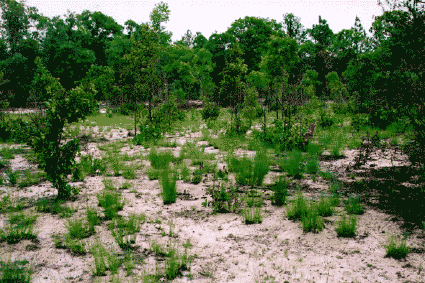
Ohoopee Dunes Natural Area, Emanuel Co., Georgia
This year's Cross expedition took place from June 16 through June 22 in southeastern
Georgia at the famous "Ohoopee
Dunes" and also at George
L. Smith State Park, both in Emanuel County. We visited four distinct Ohoopee
sites that included three Natural areas and one Nature Conservancy site. We
did most of our collecting in the South Natural Area and the Nature Conservancy
site (which adjoined the South Natural Area.) We also collected some at Smith
State Park, but it was not our primary collecting spot as it was not such a
unique habitat as the Ohoopee dunes area.
The Ohoopee Dunes are a series of inland sand dunes found on the east side of the Ohoopee River. The dunes are thought to have originated by high winds during drought periods in the Pleistocene. These dunes are very similar to the back dunes along the Gulf Coast of Alabama, where we have collected quite a bit, except these dunes are some 80 miles or so from the coast. Even the plant and animal life is reminiscent of what we would see on the coast. Basically the plant community here could be described as a dwarf oak-evergreen scrub forest. Stunted turkey oaks (Quercus laevis) seemed to be the predominant tree, with longleaf pines (Pinus palustris), bluejack oak (Quercus incana), and dwarf post oak (Quercus margaretta) also being common. Perhaps the more unusual elements found here were the woody shrubs such as Rosemary (Ceratiola ericoides), seaside, or woody goldenrod (Chrysoma pauciflosculosa) and red flowering woody mint (Calamintha coccinea). There was also plenty of blueberry (Vaccinium sp.) in fruit, some Clethra alnifolia not quite in bloom yet, and some Cyrilla racemiflora (in S.Nat. Area). Some of the herbaceous plants here were gopher apple (Licania michauxii, in bloom), sand chickweed (Arenaria sp.), nailwort (Paronychia sp.), wire plant (Stipulicida setacea), Goat's rue (Tephrosia virginiana), sand spikemoss (Selaginella arenicola), Amsonia ciliata (a little ciliate leaved plant on trail at the South Nat. Area), Baptisia perfoliatum, Lupinus diffusus, and many others. Also common here was a reindeer lichen. Gopher tortoise burrows were quite common here, although we didn't get to see a tortoise. I did manage to see a king snake one night, and indigo snakes are supposed to be here as well.
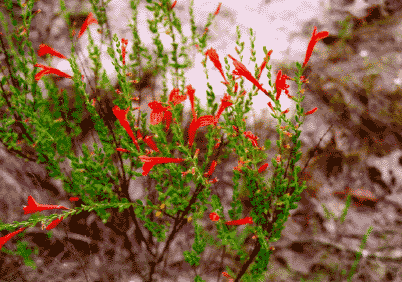
Calamintha coccinea at Ohoopee Dunes Natural Area
This year's trip had a few less participants than usual and basically just
included us museum people, Richard
Brown, Terry Schiefer,
Joe MacGown (myself), Sang-Mi
Lee (grad. student), JoVonn
Hill (grad. student to be) and our trip leader, Mark
Deyrup, from Florida. Mark is an entomologist of apparently world-renowned
fame and there probably couldn't have been a better leader for this particular
trip. Mark is a dune specialist and was quite familiar with the flora and fauna
of the Ohoopee Dunes. He also is ant expert, which was useful to us as we have
recently embarked on a native ant survey in Miss. and he gave us some information
greatly needed. As far as the rest of us go, Richard is the director of our
museum whose interests are Lepidoptera (mainly Tortricidae), aquatic insects,
and anything else that moves. Terry is a cerambycid man with ornithological
leanings and is the curator of our museum. I am an assistant curator/scientific
illustrator and as of late becoming interested in ants. Sang-Mi is Richard's
PhD student and is studying Gelechiidae. JoVonn Hill will be a Master's student
in the fall and will be working on ants of the Black Belt Prairie in Mississippi.
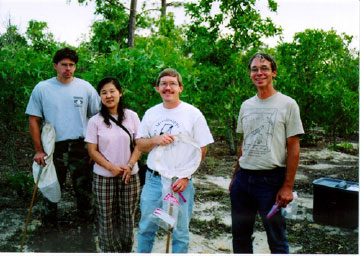
Joe MacGown, Sang-Mi Lee, Terry Schiefer, & Mark Deyrup
Terry and I arrived at George L Smith State Park sometime around 3 P.M on Sunday, June 16. Richard and Sang-Mi arrived just before us having come in from a meeting in South Carolina, and we met them at the office. Mark Deyrup arrived just ahead of us and we met him at the cabin. We unloaded our gear and supplies and proceeded to totally remodel the cabin and convert it to a lab. When all things were as they should have been, we headed out to the Ohoopee Natural Area to check out the place. The sites were all about 30 minutes away from the park, so we didn't waste a lot of time doing things like resting.
We arrived at the South Natural Area later than we would have liked and it was already near dusk. We were immediately struck by "coolness" of the place. It was like being in the back dunes at Bon Secour in Alabama, but there was no ocean nearby. We parked and entered through a gate on the south side of the road (the South Nat. Area was bisected by a road) and walked in to a scrubby turkey oak/pine forest. As we were walking, we noticed a large number of scarabs flying low on the ground and collected some of these. We thought that they were either a species of Phyllophaga or of Polyphylla. They looked different than any species we were accustomed to and everybody joked that they were some endemic new species of scarab. We later decided that they were Polyphylla (Polylamina) pubescens most likely. As we walked about further we noticed quite a few small buprestids of the genus Brachys on the leaves of the turkey oaks. After a bit, Richard put up a box trap in this site. As it was getting dark, we all headed back to the State Park to eat and blacklight there. We set up one sheet with a mercury vapor light in the mixed forest behind the cabin and we left this sheet up all week. Three sheets with blacklights were placed along the creek/drainage area near the lake. This was a nice cypress forest area just a few hundred yards or so from the cabin. I collected at the cabin light for a while before heading out to join Terry, Richard and Sang-Mi at the other three sheets. I collected until around midnight and collected insects on trees on the way back. I collected a bunch of several species of nitidulids and some other beetles on a somewhat large, woody, dark brown, convoluted, brain-like fungus growing on a standing close-to-dead tree. This fungus was later identified to be Globifomes graveolens by Richard Baird. I also collected some ants at the bases of trees including some Aphaenogaster tenesseensis, which was new to me (that's not saying much, because most of the ants are new to me.) I went back to the cabin to take care of the night's catch with Terry and Sang-Mi not long behind me. Richard stayed out later; in fact, I have no idea when he came in. Mark isn't much of a blacklighter, but I believe he did collect some at the cabin sheet. The blacklighting was not spectacular by any means and probably in part due to the drought like conditions in this area for the past few months. I avoided catching moths as a rule on this trip leaving that to Richard and his new protege, Sang-Mi. There were quite enough beetles and other insects to keep us pretty busy even so.
The next morning, June 17, Mark headed out to the Ohoopee Dunes to put out bowl traps and otherwise collect. The weather today was warm (upper 80's F°) but not humid and slightly cloudy to mostly sunny. Richard picked up the boxtrap early and was sorting it with Sang-Mi. Terry and I went to the South Natural Area to collect. We met Nate Thomas, of the Nature Conservancy, there and he showed us around and gave us some information on that site and the others. We walked down a gated road/trail on the north of the main road and not far from the spot where the box trap was located on the south side of the road. This gated road was basically a loop through the natural area and we found that this side of the road was much more interesting than the south side of the road. There seemed to be much more diversity of plants and the insect activity was more obvious here. I should mention that this site and all the others were some kind of ant heaven. There were ants and their nests everywhere. Pheidole, Aphaenogaster, Dolichoderus, Dorymyrmex, Pogonomyrmex, and many others were the dominant life forms here. Terry and I collected some while Nate was showing us around. Perhaps one of the nicer bugs I caught during this morning was a Mydas fly, Neomydas sp. Cicindela abdominalis were very common on the trail, as were many mutilids. As we walked about halfway around the loop, we came to a more open area, which Nate called the "Bald" and it was very nice indeed. This Bald had lots of woody goldenrod, rosemary, and also gopher apple,which was in flower. While in this area, both Terry and I both collected an endemic, newly described geometrid, Narraga georgiana. It was late morning getting near 11:00 A.M. and we had just entered a region with many Chrysoma pauciflosculosa plants. As we continued walking we came out into a more wooded area and finally back to the road. Terry and I went back and ate lunch and Nate left town to meet someone else.
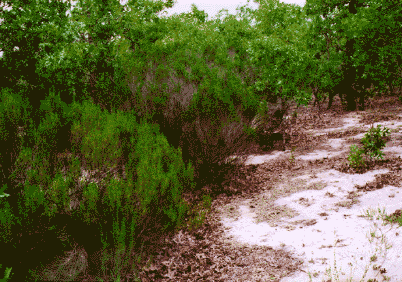
Rosemary plants at the "Bald" at Ohoopee Dunes Natural Area
After lunch, Terry and I went back to the South Natural Area to put out traps. We put one malaise trap on the gated loop road and actually stretched it out across the road itself. This road is actually more of a wide sandy trail, and it is closed to the public except during hunting seasons. We put a second malaise trap in the scrub off the trail a few hundred yards. A third malaise trap was put up in the bald area and this one was also stretched across the trail. We put out ten pitfall traps, two barrier traps, one Lindgren funnel trap, two molasses/yeast/beer bait traps, and two unbaited Japanese beetle traps in an area quite near the first malaise. We put two barrier traps, one Lindgren funnel, two molasses/yeast/beer bait traps, and one Japanese beetle trap in the same area as the second malaise trap. We put one more Lindgren funnel trap up on the south side of the road near our box trap site. After we finished putting out the traps, we collected for a while before heading back to the cabin. I caught some very interesting dimorphic ants in a nest and these ended up being Pogonomyrmex badius. These are very cool ants and are among those in North America said to have one of the nastiest stings. Fortunately, I didn't know what the ant was as I was eagerly plucking them up with my fingers. We caught a few of the Cicindela abdominalis and others insects as well.
We got back in time to eat some lasagna, which Sang-Mi and Richard had heated up. But, it was already time to blacklight again, so Richard and Sang-Mi left to go set up sheets at the South Natural Area. After hearing how nice the north side of the road was, especially down the looped trail, Richard decided to put the lights on or near the trail there. He put out three sheets with blacklights. Mark stayed at the cabin to go through berlese samples and otherwise take care of his catch. Just before Terry and I headed out to blacklight, JoVonn Hill drove up, but declined the blacklighting and opted for hanging out with the ant man.
We got a few good things I guess, but it was not real busy at the sheets by any means. I picked up a Scaphinus muticus (cerambycid) at the first sheet, that being the highlight for me. There were an amazing number of lycosid spiders running around the sand at night. We collected some of those and once in the jars we noticed the peculiar dark coloration on the underside of them. There were Geolycosa? burrows here as well, and if you watched, you could see them popping their heads up now and then. I managed to catch one of these while it was near the top of its burrow by quickly sticking a small hand-held garden shovel down below the spider cutting off its burrow. I then sifted through the sand until I found the little bugger. I attempted to capture several others, but was unsuccessful in those attempts unless you count the one I cut in half. I collected some ants that night that were running about. One of the more interesting species was the Camponotus socius, which had a beautiful color pattern on the gaster and were very active at night. At some point after midnight things slowed down and we went back to the cabin arriving there sometime after 1:00 A.M. We then checked out the M.V. lamp behind the cabin and came in to take care of specimens for the evening.
The next morn, June 18, Terry, Mark, JoVonn, and I went back to the South Natural Area to collect some more. Today's weather seemed to warm again, but not too hot or humid, somewhere in the mid to upper 80's F°. Mark had a few million blue, yellow, and white bowl traps to check in addition to his many sacks of berlese samples. JoVonn hung out with him a good bit trying to osmotically soak up ant collecting techniques. One of his more interesting ways of catching ants is with his cookies. Upon finding a suitable Pheidole nest, he would crumble up some pecan sandies (preferred cookie of all myrmecologists of any caliber) near the entrance hole in an attempt to lure the larger, big-headed soldiers out. Sure enough, within a very few minutes, they would come out, and he would then grab the mass of sand and ants throwing them in a pan to collect. Probably the most useful thing we learned from him was that you need a sifter and a white pan to pour the goods into. Anyway, while they were checking bowls and eating cookies, Terry and I were collecting rare endemics and new species of insects. Some of the insects we managed to nab were mydas flies, mutilids, wasps, ants, tiger beetles, and rare endemic geometrids. Terry also collected several of the as yet undescribed endemic cerambycid, Crossidius n. sp. He collected these by beating old woody goldenrod for a couple of hours. Terry had a tip that they were there from a fellow cerambycid guy and was quite happy to find these beetles. We continued collecting until noon at which point we were to meet Malcolm Hodges from the Nature Conservancy. Richard and Sang-Mi showed up at about the same time Malcolm did and then everybody followed Malcolm to the Nature Conservancy site.
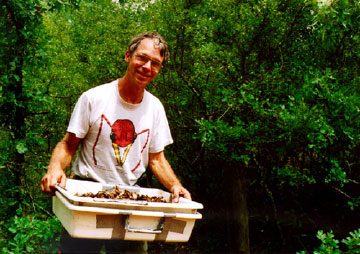
Mark Deyrup sifting some litter for ants
The first thing we did was eat the lunch that Richard and Sang-Mi so thoughtfully brought for everyone. After some food, Malcolm showed us around the place a bit. They had recently burned some of the place giving it a somewhat different appearance than the other sites, but it was essentially the same type of habitat as the South Natural Area. There were some plants present here not seen at the other site, such as Cnidoscolus stimulosus, a cool little stinging euphorb. Unfortunately, there was none of the woody goldenrod, mint, or rosemary here and it seemed a bit less interesting to me. At the edge of the scrub area there was a nice patch of woods that went down into a ravine. In the burned area there could be seen Trachymyrmex septentrionalis mounds dotting the landscape as well as the nests of so many other ants. I caught a different mydid here, the common one, Mydas clavipes (I think) and several different ants, grasshoppers, robberflies, tenebrionids, etc. I walked around with Mark and JoVonn in an effort to try and learn a few ants myself. I collected some Aphaenogaster floridana, another new one for me, and also learned to recognize their nests.
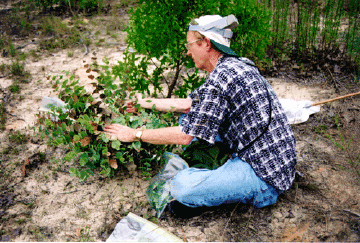
Richard Brown laying hands on Baptisia in hopes of magically pulling
forth cool tortricid moths
Sometime later in the afternoon, Richard and Sang-Mi went back to spread lepidoptera. The rest of us followed Malcolm to the Central Natural Area. We found this Central site to be very similar to the South Area, but again, without some of the cooler plants. Insect activity was maybe not quite as obvious here either, and in general we liked it less than the South Area. Probably part of the reason we didn't like it as much was the fact that we had to hike in a good ways before actually getting into the good dune habitat. We did manage to collect some things while hiking and Malcolm showed us some different things here and there. There was a Bumelia here that was a lower growing one than we were used to seeing. So many things in this dune area give the appearance of being stunted, and yet, mature. These dunes are very deep, something on the order of 50 or more feet, and I guess the plants have to do a lot of digging to get to water. The Neomydas was present here as well as the other spots, and indeed, it seemed to be a common fly here at the Ohoopee dunes (at least this week). After we followed the trail to its end down to a wooded area not far from the Little Ohoopee River, we traipsed back to the vehicles and drove back to the cabin to eat supper.
After supper, Terry, Richard, Sang-Mi and I went out for the night's blacklighting. We put three sheets and blacklights up in the South Nat. Area on the south side of the road. Malcolm came by for a while as well. The blacklighting was not very fast paced and it got cooler earlier tonight than the previous nights. The Polyphylla were still flying and came to the lights where we collected a good series of them. Terry got a Scaphinus muticus, so he was happy, but by midnight things were pretty slow and we packed up and went back to the cabin. The sheet at the cabin was checked and everyone took care of their bugs and went to bed.
Early in the morning JoVonn and Mark went to the South Nat. Area to collect. Terry and I went out not much later and got there about 9:20 A.M. The weather today was cooler with more cloud cover. We did some pretty intensive collecting in the morning finding the gopher apple flowers to be a big draw especially. The best patches of gopher apple were located just past the Bald and there was a steady stream of wasps, bees, and flies coming to it. I caught a Leptura emarginata in this area as it was flying by. I had to jump for it and was actually surprised that I managed to snag it. Jovonn managed to catch one of the Crossidius by sweeping the goldenrod. I swept it for over an hour and didn't get one. Bummer. We got more Neomydas, more Cicindela abdominalis, more of the Narraga, some really nice grasshoppers with amazing coloration, ants, beeflies, mutilids, and quite a bunch of other good things. Terry and I went back to the cabin for lunch sometime after 1:00 P.M. and JoVonn came back sometime in the mid-afternoon. Mark stayed out the rest of the day not getting back until dinner. He was as happy as clam out there. He would just sit down and see ants all around him and all things were good. After lunch, Terry went back to the South Nat. Area where he collected until coming in for supper sometime near 7:00 P.M. Richard and Terry put up the box trap in the Bald. While Richard was there, he nonchalantly caught the other sex of the Crossidius. I pinned a few moths with Sang-Mi in the late afternoon. Eventually, everyone drifted in and we ate supper.
After supper that night we blacklighted at the Nature Conservancy site and put three sheets with blacklights out. We put one down in the ravine area in the woods, one in the burned area, and the other one was placed in a power line cut just outside of the burn. The lucky participants this night were Richard, Terry, Sang-Mi and myself. A storm threatened early in the night and we thought we might have to nix the collecting. The winds were coming up and there was electricity in the air. We even took down the sheet at the powerline cut. But, alas, it passed us by and we caught bugs and all was again as it should have been. There were more cerambycids collected tonight than the previous nights and most of these were collected in the burned area. Terry picked up a nice Aneflomorpha (cerambycid) that he thought looked a little weird. We ended up staying out a little later tonight and didn't leave until after 12:45. It ended up being a contest of who could be more polite between Richard and Terry. They both thought the other was still hungry for the kill, when in actuality they were both pooped. Finally, everyone realized what was going on and we headed for Smith State Park. We checked the sheet at the cabin, which yielded a couple of species of cerambycids, and everybody went to bed.
In the morning, June 20, I went with Richard to take down the box trap. Mark went too, and he gave us a hand before getting on to the serious collecting that he so loves to do. JoVonn left for home some time early that morning before we were up. I decided to help Richard and Sang-Mi spread a few moths that day, as they were inundated with them and Richard now had another box sample to go through on top of that. The box had a few interesting things in it including a couple more of the nice Aneflomorpha and a couple more of the Narraga, not to mention who knows what micro-lepidoptera. Terry went back out to collect in the South Natural Area. While there, he collected a few specimens of the Crossidius on the goldenrod. He came in to eat lunch sometime after 1:00 P.M. Terry then went to check out the North Natural Area, a site that we had not yet seen. He came back for supper and said that the North site didn't seem be as nice as the South site. We ate supper and then a storm came through. The storm didn't last too long, but did cool things down. By the time it was over it was basically too late to drive all the way to the dunes, so we just put two sheets up on the nature trail at the state park. The collecting was very slow and we did little collecting. I mainly bugged Mark about the ant identifications that night. I also pinned a few more moths.
On the morning of June 21, Terry and I headed back to the South Nat. Area to collect some more and to take down the traps. We took down all of the traps and were happy to see there were good things in them. One thing we were hoping for after the rain was present in the traps, cebrionid beetles. After taking the traps down, we did some general collecting. We came across some coyote dung and collected scarab beetles from that. Sometime in mid-afternoon, we headed back to the cabin.
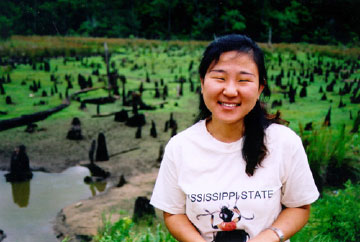
Sang-Mi hanging out in old cypress swamp
In the late afternoon, Terry and I walked across the covered bridge in Smith State park to a nice oak-scrub type habitat recommended by Mark. This place was similar to the Ohoopee area, but didn't have the cooler plants. We collected here a little (Terry did anyway). Gopher apple, Aureolaria, and a few other flowers were blooming here. This area looked like a good spot to blacklight for the night and that was the basic plan.
After supper that night we were debating whether or not we should blacklight at all because it was raining and we didn't know if and when it would stop. We (Richard, Terry, and I) drove around the back way to the scrub site within the park and walked down a gated road looking for potential sheet sites, but didn't put any out because it was raining. While we were walking Richard collected a bee (perhaps more?) in the closed flowers of Aureolaria pectinata. The rain persisted and we decided not to blacklight at all this night. We went back to the cabin and cooked and ate another great supper. Somebody got a birthday cake for my birthday, and we ate some of that. We then took care of specimens and starting packing up for the return trip home the next day.
The final day of the trip, June 22, was reserved for packing the trucks and going home. It looked to be a rainy day, and it was. I was soaked through and through just loading the truck. Mark left early in the morning before we arose. We got back to Starkville sometime around 4:00 P.M. and yet another Cross trip was over.
LOCALITY DATA AND HABITAT INFO
George L. Smith State Park
GA.,Emanuel Co.
G.L.Smith St.Park
32°32'40"N82°07'30"W
South Natural Area Loop road and north side of road
(boxtrap, 2 malaise traps, other traps)
GA.,Emanuel Co.
Ohoopee Dunes N.Area
32°31'51"N82°27'23"W
South Natural Area (Bald)
GA.,Emanuel Co.
Ohoopee Dunes N.Area
32°32'15"N82°27'40"W
Central Natural Area
GA.,Emanuel Co.
Ohoopee Dunes N.Area
32°34'32"N82°26'33"W
Nature Conservancy Site
GA.,Emanuel Co.
Ohoopee Dunes N.C.P.
32°31'17"N82°26'42"W
HABITATS
Pine-Oak dune woodland or dwarf oak forest (at Ohoopee & State Park)
Xeric dune scrub or rosemary bald or dwarf oak-evergreen shrub forest (at Bald at Ohoopee)
hardwood bluff forest (at edge of Nature conservancy dunes area)
mixed forest (behind cabin at State Park)
PLANTS COLLECTED IN OR ON
Trees
Quercus incana (bluejack oak)
Quercus laevis (turkey oak)
Quercus margaretta (dwarf post oak)
Pinus palustris (longleaf pine)
Shrubs
Bumelia sp.
Calamintha coccinea (red flowering woody mint)
Ceratiola ericoides (rosemary)
Chrysoma pauciflosculosa (woody goldenrod)
Clethra alnifolia
Cyrilla racemiflora
Polygonella polygama (jointweed)
Vaccinium arboreum (sparkle berry)
Vaccinium stamineum (deerberry)
Vaccinium tenellum (blueberry)
Herbaceous Plants
Arenaria sp. (sand chickweed)
Amsonia ciliata (a little ciliate-leaved plant)
Aureolaria pectinata (false foxglove)
Baptisia perfoliatum
Cnidoscolus stimulosus (risky treadsoftly, a stinging plant)
Licania michauxii (gopher apple)
Lupinus diffusus
Paronychia sp. (nailwort)
Selaginella arenicola (sand spikemoss)
Stipulicida setacea (wire plant)
Tephrosia virginiana (Goat's rue)
Fungus (G. L. Smith St. Pk.)
Globifomes graveolens


